South Wales and Monmouthshire Truant / Industrial School for Boys, Treharris, Glamorgan
In 1893, a group of South Wales school boards opened a Truant Industrial School in purpose-built premises at Quaker's Yard, Treharris, near Merthyr Tydfil. The establishment housed incorrigible truants who were subjected to a strict regime before being released on licence. Subsequent truancy from normal schools would result in re-admission to the Truant School for a longer period, coupled with corporal punishment. The buildings were formally certified to begin operation on November 8th, 1893, with accommodation for 60 boys, aged from 8 upwards. The School began practical operation in January of the following year. The staff initially comprised the superintendent, Mr William Davies; matron, Mrs J. Courtenay; schoolmaster, Mr T.J. Heath; general assistant, Mr Tucker; workmaster, Mr Whitton; two female assistants, cook, and laundress.
The School site is shown on the 1900 map below.
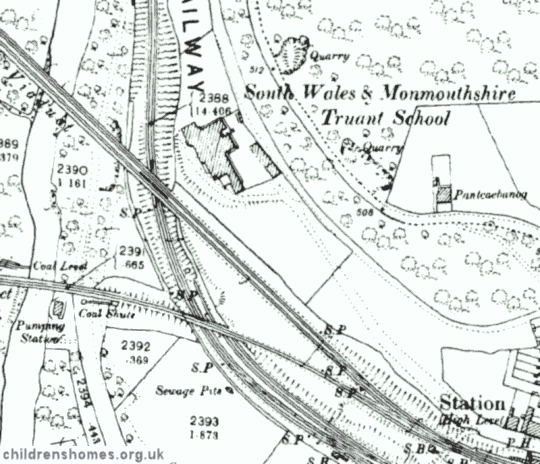
South Wales and Monmouthshire Truant / Industrial School for Boys site, Treharris, c.1900.
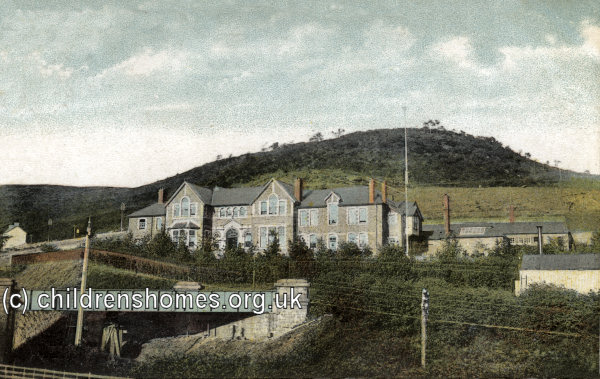
South Wales and Monmouthshire Truant / Industrial School for Boys from the south-east, Treharris, early 1900s. © Peter Higginbotham
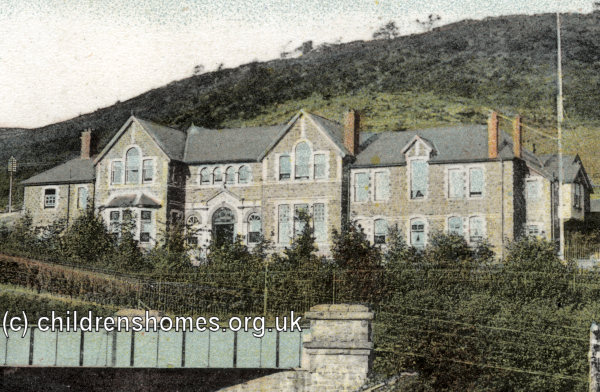
South Wales and Monmouthshire Truant / Industrial School for Boys, Treharris, early 1900s. © Peter Higginbotham
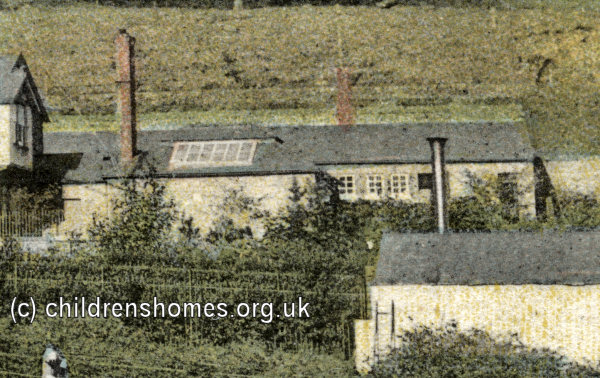
South Wales and Monmouthshire Truant / Industrial School for Boys, Treharris, early 1900s. © Peter Higginbotham
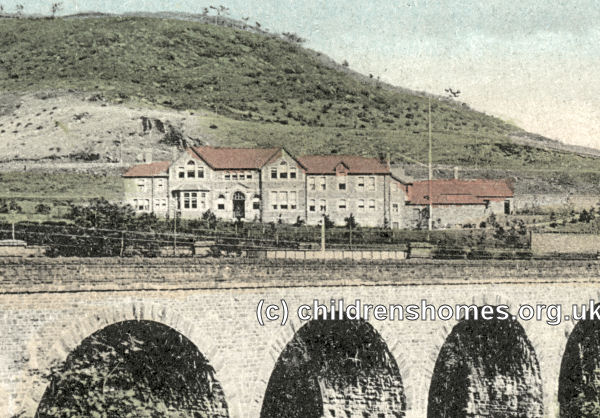
South Wales and Monmouthshire Truant / Industrial School for Boys, Treharris, early 1900s. © Peter Higginbotham
An inspection report in 1896, noted that the School was surrounded by a garden of about two acres which were in excellent order and cultivation. In the washroom was a plunge bath measuring 15 feet by 9 feet. All the boys mended their own clothes and there were a few who darned socks. Laundry work occupied sixteen boys, and housework another six. The boys received drill instruction for 1½ hours each day.
The boys' daily timetable in 1896 is given below:
| 6 a.m. | Rise and clean the House and School |
| 7.30 | Wash |
| 8.00 | Breakfast |
| 8.20 | Recreation |
| 8.45 | Prayers |
| 9.00 | School or industrial work |
| 12.00 | Drill |
| 1 p.m. | Dinner |
| 1.30 | Recreation |
| 2.00 | School or industrial work |
| 5.00 | Drill |
| 5.30 | Wash |
| 6.00 | Supper |
| 6.30 | Scripture lesson. Singing lesson on Tuesday and Thursday |
| 7.15 | Recreation |
| 7.45 | Prayers |
| 8.00 | Bedtime |
The boys were divided into two divisions, one doing school work in the morning and industrial work in the afternoon, the other having the reverse allocation.
In 1897, Miss Toft, a trained nurse, took over as matron. In February, 1899, Mr W.J. Broome succeeded Mr Davies as superintendent, and also took on the role of schoolmaster. At the same time, Mrs Broome replaced Miss Toft as matron. Mr Ithel Jones was appointed schoolmaster in December, 1898. The other staff comprised the porter and shoemaker, Mr White; labour-master, stoker, cook and laundress.
The whole of the front part of the roof had to be renewed in 1899 owing to defective workmanship and material. The drains also had to be reconstructed and improved. Boot repairing now occupied six boys, and dumb-bell exercises had been introduced, together with a half hour's play each day. Under the new superintendent, the use of the birch was discontinued, canings became much less frequent, and punishment on re-admission was ended.
In 1900, drawing was introduced and a manual instruction class started. The repairing of clothes and boots was continued, with net-making and rug-work added to the industrial occupations. The matron carried out the teaching of darning, needlework and knitting. Sand modelling, crayon drawing etc. were given to the small boys. Instruction was given in gymnastics. A library was provided for the boys. Badges in connection with the Christian Endeavour Society could be earned by well-conducted boys. Mr John J. Ellis was now assistant schoolmaster.
A manual training room was built in 1902. Some football matches were played against outside teams, all of them being won by the School. A field on the high ground near the school was rented as a play-field. Mr C.E. Morrell became assistant schoolmaster, but was succeeded in August, 1902, by Mr Brennan, and in March, 1903, by Mr George F. White.
In 1904, the drill shed was converted into a gymnasium, and a field adjoining the School was purchase for use as a recreation ground. Mr A. Phillips was appointed as second assistant teacher. The regular industrial occupations were gardening, carpentry and painting. A long succession of assistant teachers came and went. From 1906, the matron, Mrs Broome, was also listed as being schoolmistress.
A brass band of 18 performers was begun in April, 1907, and a bandmaster appointed. The School's Committee purchased a piece of ground, just over 4,000 square yards in area, lying between the garden boundary wall and the Great Western Railway station. It was proposed to use the larger portion of this as a recreation ground, with the remainder being brought under cultivation. The mark system now offered early release on licence to well-behaved boys.
In 1911, a new swimming bath was constructed measuring 33 feet by 16 feet, and a new hot-water cylinder, with 40 feet of steam pipes for drying towels, was installed in the boys' lavatory. Each boy was supplied with a tooth-cleaning outfit. Manual instruction (woodworking), tailoring and gardening were now the principal industrial occupations. That year's report noted that of 35 boys who had left the school over the previous year, 34 had entered skilled or progressive occupations and in some cases were earning exceptionally good wages in the pits.
From 1922, the establishment became an 'ordinary' Industrial School, receiving boys sentenced by the courts to a period of detention. In February, 1926, the official capacity of the School was reduced to 75 places.
In 1933, the establishment became an Approved School, one of the new institutions introduced by the 1933 Children and Young Persons Act to replace the existing system of Reformatories and Industrial Schools. The School accommodated up to 75 Junior Boys aged below their 13th birthday at their date of admission. The headmaster, as he was now termed, was Mr T. Isaac.
On 5 April 1950, the School's managers gave formal notice of their intention to surrender its Certificate of approval and the establishment finally closed in 1952. The premises were subsequently occupied by the Dyffryn Taff Home for the Aged. The buildings no longer survive and the site is now occupied by modern housing.
Records
Note: many repositories impose a closure period of up to 100 years for records identifying individuals. Before travelling a long distance, always check that the records you want to consult will be available.
- Glamorgan Archives, Clos Parc Morgannwg, Leckwith, Cardiff CF11 8AW. Holdings include: Admission register (1894-1909); Particulars of children committed to school, plus Petty Sessional Orders (1909-20); School Managers' and General Committee minute books (1891-1952); Other minutes (1906-13 (with gaps), 1934-35, 1949-50); Rules and regulations (1896-1926); Inspection returns and reports (1898-1914 (with gaps), 1939 (printed)).
Bibliography
- Higginbotham, Peter Children's Homes: A History of Institutional Care for Britain's Young (2017, Pen & Sword)
- Mahood, Linda Policing Gender, Class and Family: Britain, 1850-1940 (1995, Univeristy of Alberta Press)
- Prahms, Wendy Newcastle Ragged and Industrial School (2006, The History Press)
Links
- None noted at present.
Except where indicated, this page () © Peter Higginbotham. Contents may not be reproduced without permission.


